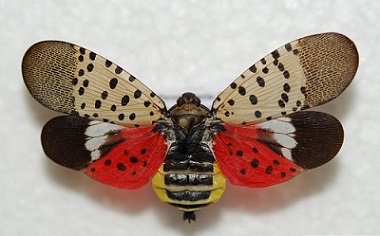By Jennifer Pfeiffer
Earth Matters focuses on conservation, sustainability, recycling and healthy living.
If Earth Matters to you, sign up for our mailing list and get the next installment delivered bright to your inbox.
The Spotted Lanternfly has arrived in Rockland. It’s a pretty little insect, but this Asian plant hopper can spread rapidly and damage both ornamental and agricultural plants. First observed in the U.S. in 2014 in southeastern Pennsylvania it has since been seen all along the east coast from Virginia to Connecticut. It has been spotted throughout the state of New York, and locally it was observed in late 2020 in the towns of Port Jervis, Sloatsburg, and Orangeburg.
These creatures threaten the forestry, agricultural, and tourism industries in New York, as the insect feeds on many tree species. It has no native predators but song birds, chickens, and Preying Mantis’ have been observed feeding on them. The Tree of Heaven is the insect’s preferred host, though it will also feed on maples, walnuts, and apple trees, as well as vines including hops and grapes.
It eats the sap found in the leaves, stems, and trunk causing oozing sap, wilting leaves, and branch dieback. And it excretes honeydew that may attract other insects and sooty mold. These impacts may not necessarily kill the host plant on their own but will cause significant stress, decreasing the plant’s ability to deal with other pests or diseases.
Look for Spotted Lanternfly over the course of its one year life cycle. It is easiest to spot in the adult stage, when it measures approximately one inch long and is very colorful with red, yellow, white, and black markings.

Spotted lanternfly, Photo: Lawrence Barringer,
Pennsylvania Department of Agriculture, bugwood.org
The adults are found in large numbers along the trunks and stems of their host plant and are most active at dusk. They don’t survive winter, but their egg masses do. The eggs can blend in with the bark of the host tree or vine. They can also be found on a number of other surfaces including vehicles, landscape and construction material, shipping containers, and firewood.
That means it’s important to be alert to avoid spreading egg masses left on surfaces. If you do find them, physically removing them and applying sticky ban traps for nymph and adults are recommended. There are also insecticides registered with New York State for residential and commercial uses that have proven effective in controlling these insects.
If you suspect you have seen the Spotted Lanternfly in any of its life stages, email spottedlanternfly@agriculture.ny.gov with photographs and the location. If it is possible to collect the insect, place it in a sealable plastic bag and freeze it.
Links
Cornell Cooperative Extension of Rockland County
New York Invasive Species Information
New York State Department of Environmental Conservation (NYSDEC)
Jennifer Pfeiffer is an ISA Certified Arborist NY is an ISA certified arborist working for Emerald Tree and Shrub Care, Inc. and a member of the Nyack Tree Committee
Earth Matters focuses on conservation, sustainability, recycling and healthy living. This weekly series is brought to you by Julie Wendholt, Financial Advisor & Vice President of Pell Wealth Partners, a private wealth advisory practice of Ameriprise Financial Services, LLC.










